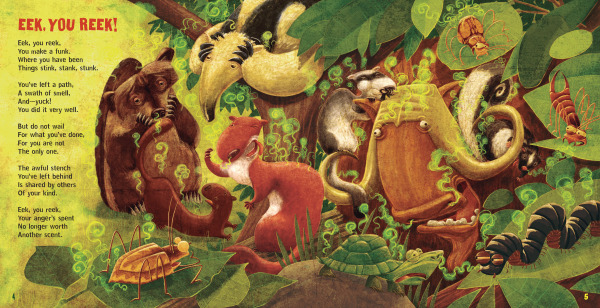TeachingBooks is delighted to welcome authors Jane Yolen and Heidi E.Y. Stemple as our featured guest bloggers this month.
Each month, we ask distinguished authors or illustrators to write an original post that reveals insights about their process and craft. Enjoy!

Eek, You Reek!
by Jane Yolen and Heidi E.Y. Stemple
We are book nerds. We are word nerds. Yup. We admit it.
We are authors, poets, and also mother and daughter.
Heidi: While this book was my mom’s idea, I am the co-author, or, more specifically, co-poet. Initially, I thought the idea for a poetry book about stinky animals was a bit flimsy. But, as soon as Lerner bought it, I knew I’d better get on board quickly. And, I did. The project came to me half done with a deadline. My mom smugly told me “I told you so,” and announced that I had better get to work. Oh, I should have added, I’m a deadline nerd. I work much better under pressure. There was much research to be done. Each poem, no matter how short, is backed by tons of research. Once the poems were written, we switched poems and I read hers and she read mine.
Jane: Heidi and I have been working together for years. Our first project was a short story for a book called Great Writers and Kids Write Spooky Stories (Random House 1998). Not only was it the start of some 25+ books together (of which I believe Eek, You Reek! is the 26th) but we began the process of learning how to put aside the mother-daughter relationship when working on books. Especially revisions. In the book process, we become two professional writers hammering out problems together. Each of us gets the chance to be heard. Neither of us has final say.
In that first story, Heidi deferred a lot to me. (She is NOT a deferring sort of woman.) But quickly she began to understand that I make mistakes, too. Sometimes we work so closely together, we can’t even remember who wrote which line. In the case of Eek, You Reek! (Lerner 2019), we have also argued about who really wrote which poem. (She is thirty years younger than I am, has a better memory, and takes better notes!)
Heidi: OK, to be clear, we haven’t argued. You thought I had written the stinkpot turtle poem, but you wrote it. I know because I sent you the research for it and said, “write this poem.” You called to read it to me—having amused yourself with the rhyme of the scientific name odoratus. I’m happy that you took that assignment, but you’re doing a lousy job on this one. I sent you a note saying “talk about the revision process here.” Can I nudge you back in that direction? (You can see how we work together—I make lists and outlines and my mom flies off into the mist until I reign her back in.)
Jane: Hauled or keelhauled, I am reprogrammable. When Heidi and I revise, we do it both individually and aloud to one another. If we are both at my house, we sit at the dining room table across from one another and one of us reads a poem (or a picture book) aloud. The other takes notes, and then we discuss the poem or picture book, line by line, syllable by syllable. These are books meant to be read aloud.
But these are also books that do not come along with the actual poet reading to the child. So Heidi and I change and I read her poem aloud, she reads mine. Nothing gives a poet more information about what is wrong with a piece than having it read aloud by somebody else because that reader almost always stumbles over awkward lines, or puts the emPHAsis on the wrong sylLABle.
Heidi: So, the poems had been written and revised. But, the fun had just begun. Since we had so much extra information from our research, and you can never get all the facts into a poem (or, more accurately, if you try to get all the facts into a poem, it ruins the poem), we had written informational marginalia for each animal. Marginalia just means supplemental (usually nonfiction) information that is in the margins instead of in the main text. When we first envisioned it, these marginalia were not only right on the page with the poems, but it was also encyclopedia-esque straight facts. Our editor was the one who asked if it could all be moved to the back and at some point we all decided it would be hilarious if the backmatter (the same stuff that had originally been marginalia) matched the silly tone of the poems. What resulted was a cohesiveness that is my favorite part of the book. When I am researching for a poem, I also pull out lists of fun words associated with my subject. I submitted all the words we used that meant “stinky” and those got used in the backmatter, too. Which is hilarious. Somewhere along the way someone had the brilliant idea to define those words which, as you can imagine, was a challenge since they all mean the same thing.
Jane: The book is now out, but we so much enjoyed working on it, we pitched a companion book to the editor: Yuck, You Suck: Animals Who Eat by Sucking. [Publisher’s note: look for it in a few years!] Yes, vampire bats are there of course. Possible vampire finches, too. (Really? Really!) Leeches and other creatures. When you are a writer, you have to be three, four, or five steps ahead. And we always, always keep our fingers crossed. Nothing is real until the book is in the hand.
Heidi: The sum of its parts. For a book I wasn’t sure about, this absolutely came together in ways neither of us would have imagined. I love that the organizing theme is not only the stinky animals, but also the consistency of the wordplay and humor. And, can we talk about the art? Most times, and this book isn’t an exception, the author (or in our case authors) doesn’t get to see the art before it’s sketched out. Our editor did let us get a vote in choosing the artist. We were sent 4 ideas and we unanimously all chose Eugenia Nobati’s quirky style for this book. She brought the humor out in a perfectly odd color palette. And, she managed to draw stench! I just love the wafting odors that, thankfully you can only see and not really smell.

Jane: Speak for yourself, kiddo. When I first opened the pages of the book and saw the final full color work, I smelled it all—skunk, musk ox, weasel, bombardier beetles and the rest. Eugenia’s particular genius made it all happen. She deepened and broadened the text, not simply decorated it. She made the poems even funnier than they are on their own. And we haven’t even gotten to meet her yet, except through the pages of the book.
Not all of every book process is face-to-face or even pixel-to-pixel. In this case, the conversation was poem-to-paint. Editor and Art Director were the midwives.
In book terms, we were all partners in the best senses of the word. And the book was made better because of that.

Explore resources for books written by Heidi E.Y. Stemple.
Explore resources for books written by Jane Yolen.
Text and images are courtesy of Jane Yolen and Heidi E.Y. Stemple and may not be used without their expressed written consent.


Leave a Reply